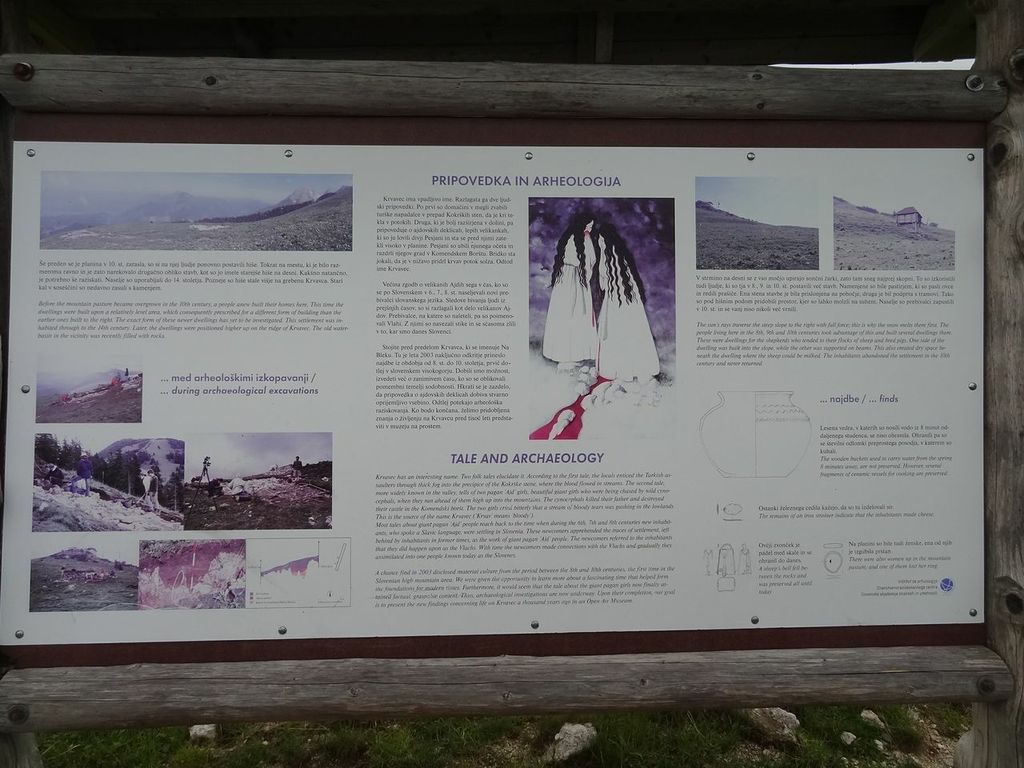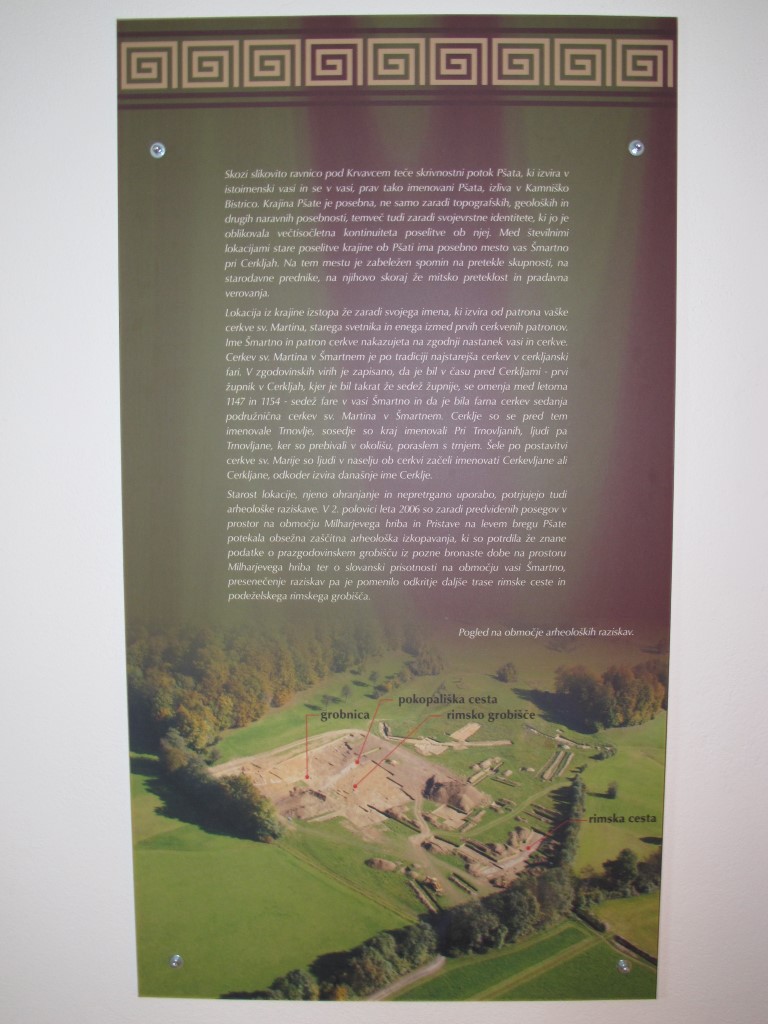Archeological sites
Štefanja Gora Archeological site
Archaeological sites at Šmartno and Krvavec bear witness to the ancient settling of the population in this region.
Findings in the area of today's municipality, on the terraces below the St. Štefan church, are actually traces of inhabitation in the older stone age (as a living station in the open), which is confirmed by uncovered items, made from various kinds of stones.
The place is mentioned as early as 1132 for the first time, then as St. Štefan Mountain. West of the village, the St. Štefan church stands, built in the year 1805, moved to the hill Štefanja Gora (748m), which is an exceptional lookout point.
Krvavec Archeological site
At Blek the team from the Institute of Archaeology in 2003 began excavations which revealed that there were at least 2 settlements in the area, these being early medieval from the 9th to the 10th century, and then late medieval from the 13th to the 15th century.
According to the archaeologists, the latter is shown in the remains of the houses of shepherds, who were by then already using Krvavec for seasonal grazing. Grazing was extemely important in the Middle Ages.
In Krvavec, sheep and pigs were herded initially, and with the growing number of large cities cheese became of great interest. Due to this, large cheese dairies were built, which have not yet been discovered. However, horse stables have since been found.

Šmartno archelogical site
Among the many sites of old settlements on the landscape, the village of Šmartno has a special place. Even the name of the place is special, coming from the patron of the village church St. Martin, an old saint and one of the very first church patrons. Prehistoric burial sites from the Late Bronze Age were discovered by the Milharjev hill, as well as a long route of Roman roads and Roman rural cemetaries.
On the Old Road
The first road network and infrastructure, which included a control station, a roadside stop for supply, rest and sleep for travelers, a stop for horses as well as distance markers in miles called 'miljniki', were built on Slovenian territory by the Romans at the end of the first century. Public roads were built throughout the empire in accordance with general Roman standards. Care and control of these as well as the provincial administration lay with the central office in Rome, which was controlled by the emperor. There was a broad and multi branched road network connecting the Roman Empire. These included the roads between the villages of Poženk and Šmartno. This is a short section of the village road, leading from the Roman Emona, across the Sava river, further to Gameljne and Šmartno below Šmartno mountain, through Skaručna, Polja and Utik, toward Lahovče in Šmartno near Cerklje, Šenčur and then on to Kranj and Roman Carnia. Caring for the restoration and maintenence of these roads lay not with the jurisdiction of Rome, but instead with the local community. Construction standards and laws that apply to state roads were not taken into account when building these roads, and they were built entirely with materials of local origin. Items that are found on the road or beside it give clues as to the time when it was in use. A particularly high quality product found in the road was a bronze buckle in the shape of two horses, from the end of the 6th or th beginning of the 7th century. This was used for fastening the belts and straps for hanging moneybags, handbags, knives, or even used as an aquiver for the arrows. The oldest discovered objects are two bronze coins of Emperor Tiberius, who reigned from 14 to 37 AC, and the youngest being a bronze half moon earring from the 10th century. A large number of iron pins, which would have fallen from the soles of Roman shoes, were also preserved. The road was built around 2000 years ago and was used for almost 1000 years.
Two worlds, the world of the living and the dead
In ancient times it was widely believed that a dead person then goes down to the underworld of death, or the world below. The underworld was called Had, named so after the master of the dead and ruler of the underworld, Zeus' brother Hades. The way to the dark Had's kingdom led across the underworld river Aheront. The dead were transported across the river by a gloomy and sullen old man, the underworld boatman Haron, who charged for his se
Services a silver coin. The coin was placed in the mouth of the corpse which paid for their passage, so as to ensure that his soul would not forever roam along the banks of Aheronta. The path to the dark underworld was illuminated with a light or an oil lamp. Urban design of the settlement was defined by the brook Pšata, which in the rituals and symbols of ancient populations represented a dividing line between two worlds. The residents of the living world on one part of the bank and the necropolis, the resting place of the dead, on the other side of the stream.
Tomb, eternal home
Tombs are resting homes for the deceased, places where the dead reside. In ancient times it was considered an eternal home for the deceased person's soul. The image of the grave as a residence of death is reflected in grave architecture which mimics a house. The goods that were then laid into the grave show the caring of the living that the dead should feel at home. These goods usually included jugs, cups and cans, as well as personal items.
Cemetery, a place of rituals and graves
The ancient cemetery was a place where offerings were held according to prescribed rituals for the deceased and their burial – cremation, donations or sacrifices for underworld gods and laying cremated bones or corpses into the grave cave. Based on the objects found in the graves of the Šmartno settlement it is concluded that a small community lived there, who buried their dead after the Roman custom of cremation. The place where the dead were burned was called agility. Here wood was placed into a pile and the deceased was placed onto it, with gifts such as flowers, strands of hair, wool ribbon, cans of perfurmed oils, precious clothes and pieces of sacrificial meat placed besides. When the fire was going out, the embers were extinguished with wine. The related women then collected the burnt bones from the ashes and placed them in the urn or in the grave pit. Roman religious rules also stipulated that at the funeral of the deceased a sow had to be sacrificed for the goddess Ceres. This sacrifice allowed an easier transition into the world beyound, so only through sacrifice could the deceased's grave become a place of dedication, clearly seperated from the world of the living. Characteristic of the ceremony was the use of an iron scoop. It was used before the sacrifice when the sacrificer on the altar donated wines and spices, and invited the goddess Ceres to the ritual feast by praying.
Graveyard
49 graves were investigated, which lay on the cemetery road. With the exception of seven, the deceased were all burnt on piles such as the one mentioned above, and buried in a simple round or oval grave in which items were also placed. The remains were stored in a glass urn, and that was kept in the lime earthenware bowl, beside which decorative items were added (silver buckles, earrings and rings etc). Coins that were found here determine the time of the burials, ranging from the second half of the 1st century to the 4th century.



